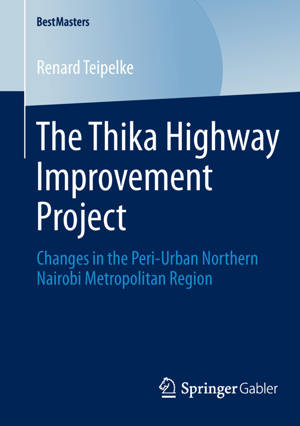
- Afhalen na 1 uur in een winkel met voorraad
- Gratis thuislevering in België vanaf € 30
- Ruim aanbod met 7 miljoen producten
- Afhalen na 1 uur in een winkel met voorraad
- Gratis thuislevering in België vanaf € 30
- Ruim aanbod met 7 miljoen producten
Zoeken
The Thika Highway Improvement Project
Changes in the Peri-Urban Northern Nairobi Metropolitan Region
Renard Teipelke
€ 97,95
+ 195 punten
Omschrijving
Theory and practice of high-capacity infrastructure projects are the major focus in the development of countries in the Global South. Aiming at a more fine-grained understanding of such projects, Renard Teipelke studies the Thika Highway Improvement Project (THIP) and its outcomes in the peri-urban Northern Nairobi Metropolitan Region. The THIP is a large transportation infrastructure project that expanded the dual carriageway Thika Road into an eight-lane highway from 2008 until 2012. Based on a strategic mix of methodological approaches, such as interviews with experts in Kenya, literature research and field visits, the 'black box' THIP is opened up. In the empirical analysis, the project's idea, its design, and its implementation are studied. It is concluded that the project's outcomes are ambivalent - partly living up to the expectations of THIP proponents but not resulting in shared benefits for all concerned stakeholders due to flaws in managing the development in this peri-urban transport corridor area, thereby fitting into the Kenyan context of politics and planning.
Specificaties
Betrokkenen
- Auteur(s):
- Uitgeverij:
Inhoud
- Aantal bladzijden:
- 163
- Taal:
- Engels
- Reeks:
Eigenschappen
- Productcode (EAN):
- 9783658045388
- Verschijningsdatum:
- 27/12/2013
- Uitvoering:
- Paperback
- Formaat:
- Trade paperback (VS)
- Afmetingen:
- 148 mm x 210 mm
- Gewicht:
- 240 g

Alleen bij Standaard Boekhandel
+ 195 punten op je klantenkaart van Standaard Boekhandel
Beoordelingen
We publiceren alleen reviews die voldoen aan de voorwaarden voor reviews. Bekijk onze voorwaarden voor reviews.











